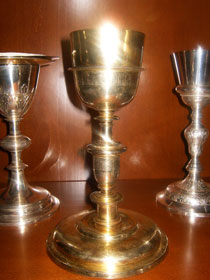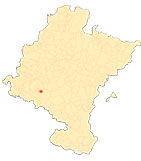Parish Church of the Assumption of Lerín
The liturgical trousseau
Among the liturgical objects in the trousseau of the parish church of Lerín are various pieces of goldsmith's work and textiles intended for the magnificence of divine worship. The silverware includes a purist chalice from the first third of the 17th century made by the silversmith Zabalza. Also of note are a silver reliquary from the 18th century subject ostensory of San Luis Gonzaga and a beautiful neoclassical pointer from the 19th century. The textiles include two large 18th century tunics, most probably made by the Zaragozan embroiderer José Lizuáin. The first is white, made of satin and richly embroidered with coloured embroidery reproducing plant decorations. The two altar frontals or pulpit draperies stand out. In each of them, a large medallion depicts the Assumption between nines and angels and Saint Barbara against a background of architecture. The other robe, in red, is richly embroidered in gold and silver, without coloured silks, depicting vases, plant motifs and bouquets. As in the first, the two fronts depict the Assumption and Saint Barbara in similar medallions.
-
FERNÁNDEZ GRACIA, R, El retablo barroco en Navarra, Pamplona, Government of Navarre, 2002.
-
GARCÍA GAINZA, M.C. and others, Catalog Monumental de Navarra, II**. Merindad de Estella, Pamplona, Government of Navarra, 1983.
-
GARNICA, A. AND ONA, J.L. (coords.), Lerín. Historia, naturaleza, arte, Lerín, Lerín Town Council, 2010.
-
TARIFA CASTILLA, M.J., "La iglesia parroquial de Lerín: ejemplo excepcional de arquitectura manierista en Navarra", Príncipe de Viana, 246, 2009, pp. 7-40.












